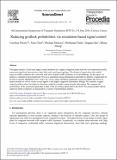Reducing Gridlock Probabilities via Simulation-based Signal Control
Author(s)
Chen, Xiao; Marsico, Michael; Talas, Mohamad; Gao, Jingqin; Zhang, Shitao; Osorio Pizano, Carolina; ... Show more Show less
Download1-s2.0-S235214651500037X-main.pdf (431.5Kb)
PUBLISHER_CC
Publisher with Creative Commons License
Creative Commons Attribution
Terms of use
Metadata
Show full item recordAbstract
This paper studies a fixed-time signal control problem for a highly congested urban network with multimodal traffic, numerous signalized intersections, short links and a grid-type topology. The design of signal plans that indeed improve traffic conditions for a network with such complex traffic dynamics is a real challenge. In this paper, we propose a simulation-based approach. We use a simulation-based optimization algorithm to identify a signal plan for an area in eastern Manhattan (New York City, USA), where spillbacks frequently occur and impact the flows on major arterials as well as on the access/ egress to the highly congested Queensboro Bridge. We consider a signal control problem where the objective function explicitly considers queue-length information. We compare the performance of the proposed signal plan to that of the prevailing signal plan in the field. The proposed plan indeed improves traffic conditions as measured by a variety of performance metrics. Keywords: queue-length; spillbak; simulation-based optimization; signal control; highly congested urban networks
Date issued
2015-04Department
Massachusetts Institute of Technology. Department of Civil and Environmental EngineeringJournal
Transportation Research Procedia
Publisher
Elsevier BV
Citation
Osorio, Carolina et al. “Reducing Gridlock Probabilities via Simulation-Based Signal Control.” Transportation Research Procedia 6 (2015): 101–110 © 2015 The Authors
Version: Final published version
ISSN
2352-1465